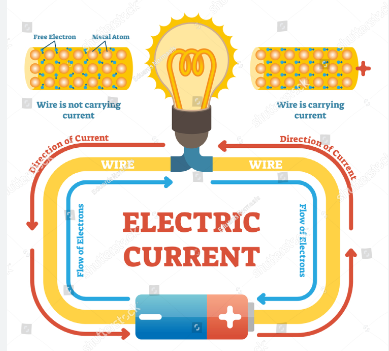From Lightning Bolts to Lightbulbs:
Exploring Current Electricity
Current electricity is like a river of tiny lightning bolts flowing through a magical pathway of wires, powering everything from your phone to your favorite toy! While static electricity flows suddenly as static discharge, current electricity is a continuous flow of electric charge.
Points to note:

Electricity is the flow of tiny particles called electrons, which are negatively charged, through a material.
Current electricity is the flow of these electrons through a material that is connected in a loop, called a circuit.
Think of a circuit like a road for electricity to travel on, just like how cars need roads to drive on.
A circuit is made up of different parts, including a source of electricity, like a battery or power outlet, and wires or other materials to conduct electricity, like metal.
The force that pushes electrons through a circuit is called voltage. Voltage is like the pressure in a water hose that pushes water out. The higher the voltage, the more electrons flow through the circuit.
Think of a circuit like a water park slide, where the voltage is the height of the slide. The higher the slide, the more water can flow down it.
Voltage is measured in units called volts. A battery might have a voltage of 1.5 volts, while a power outlet might have a voltage of 120 volts.
The flow of electrons through a circuit can be used to power things like lights, TVs, and computers. When you turn on a light, the electricity flows through the wires in the circuit and powers the lightbulb, making it light up.
In order for a circuit to work properly, all the parts must be connected in a complete loop. If there is a break in the loop, the electricity can’t flow, and the circuit won’t work.
Think of a circuit like a roller coaster track that has to be a complete loop for the roller coaster to run smoothly. If there’s a break in the track, the roller coaster won’t move.


